Small Business Management Report: Challenges, Decisions, Advantages
VerifiedAdded on 2021/12/21
|13
|2618
|20
Report
AI Summary
This report provides a comprehensive overview of small business management, focusing on small and medium-sized enterprises (SMEs). It begins with an introduction to SMEs, their significance in the UK and European economies, and the challenges they face, particularly in securing funding. The report then critically evaluates business decisions related to starting and developing new ventures, highlighting the role of SMEs in job creation and innovation. It discusses the advantages of small businesses, such as personal customer relationships, flexibility, and innovation, while also addressing disadvantages like brand recognition, higher costs, and limited budgets. The report also explores the impact of workplace innovation on SMEs and concludes by emphasizing the importance of strategic planning for small businesses to overcome challenges and achieve success. The report references several academic sources to support its findings.
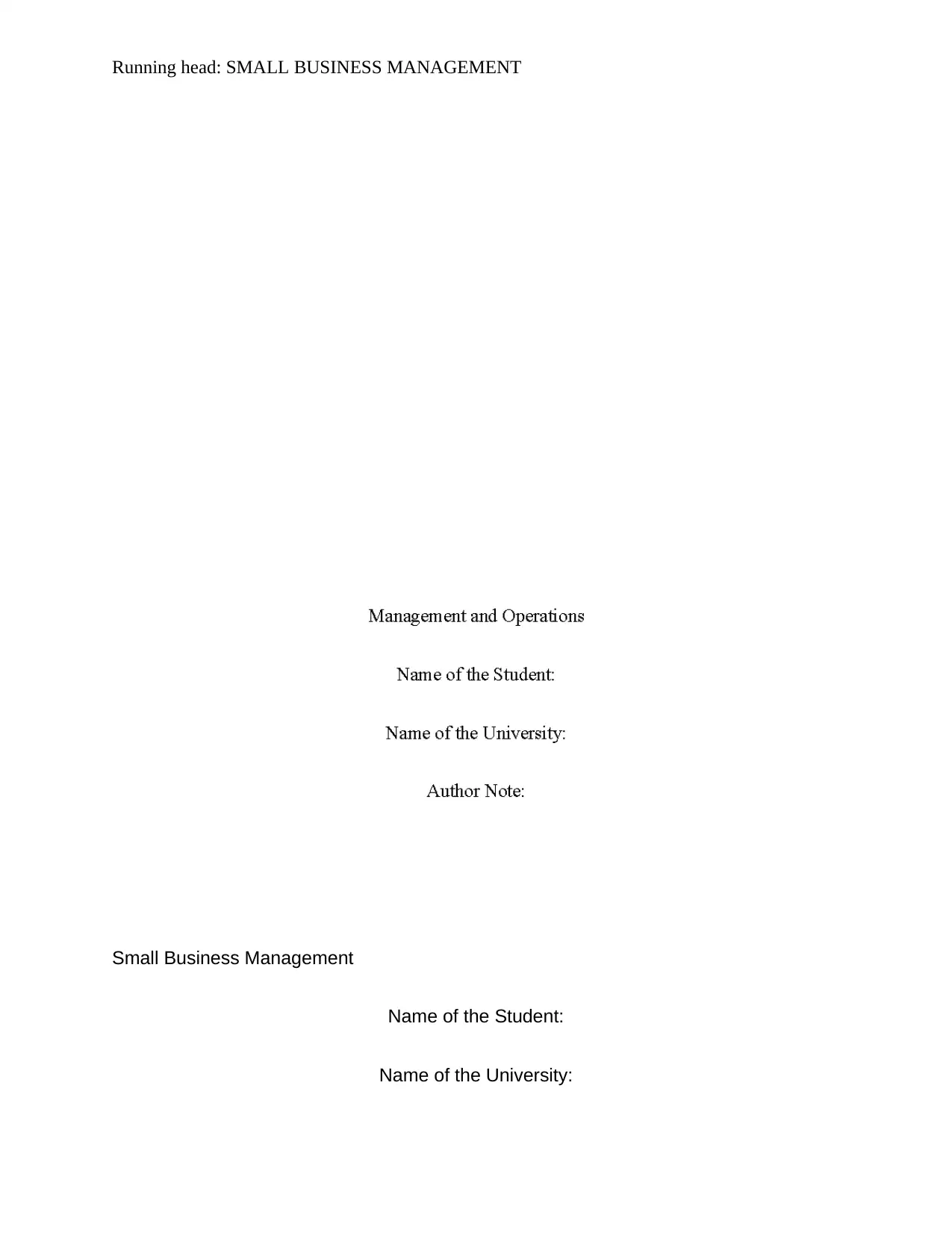
Running head: SMALL BUSINESS MANAGEMENT
Small Business Management
Name of the Student:
Name of the University:
Small Business Management
Name of the Student:
Name of the University:
Paraphrase This Document
Need a fresh take? Get an instant paraphrase of this document with our AI Paraphraser

PAGE \*
MERGEFOR
SMALL BUSINESS MANAGEMENT
Author Note:
MERGEFOR
SMALL BUSINESS MANAGEMENT
Author Note:
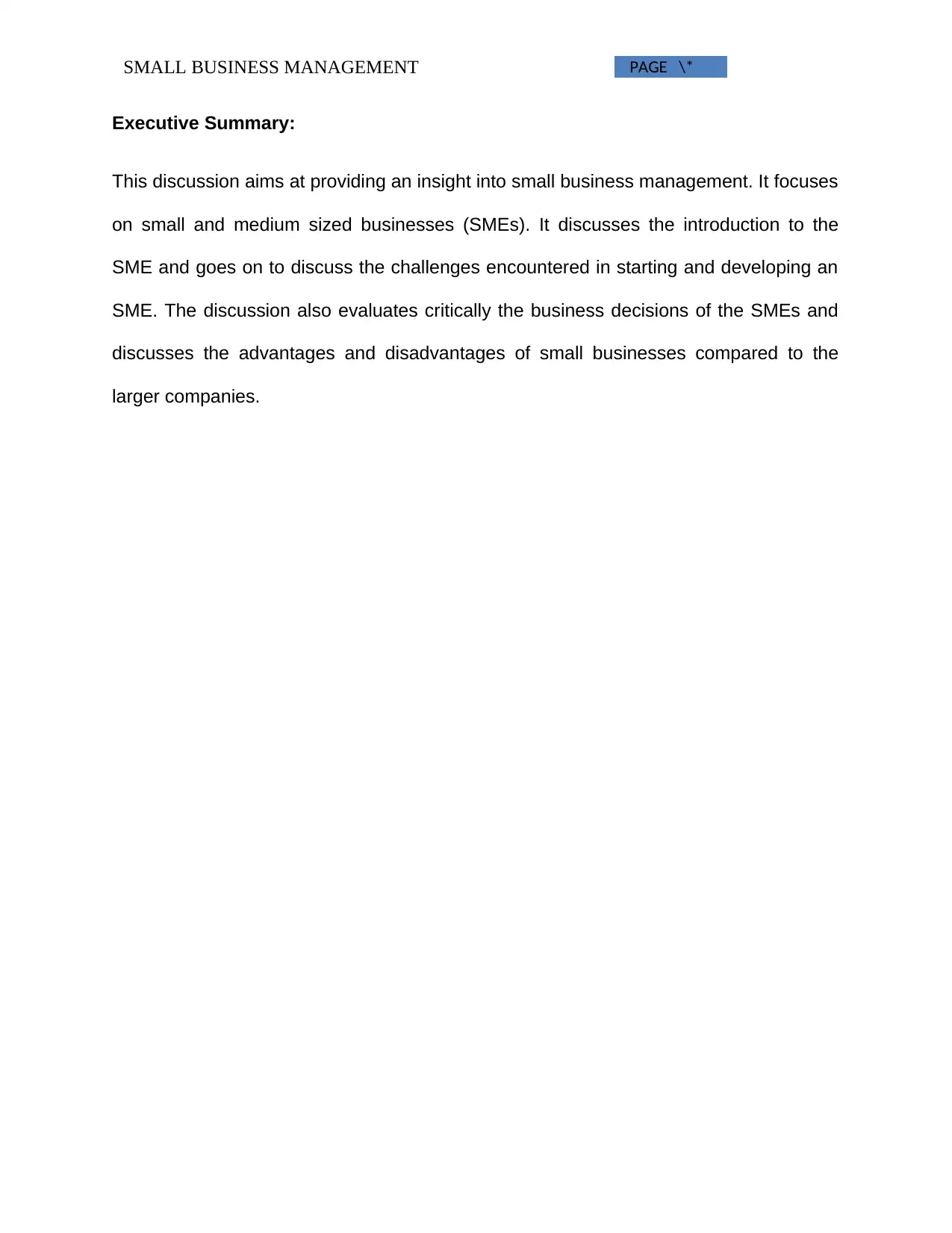
PAGE \*
MERGEFOR
SMALL BUSINESS MANAGEMENT
Executive Summary:
This discussion aims at providing an insight into small business management. It focuses
on small and medium sized businesses (SMEs). It discusses the introduction to the
SME and goes on to discuss the challenges encountered in starting and developing an
SME. The discussion also evaluates critically the business decisions of the SMEs and
discusses the advantages and disadvantages of small businesses compared to the
larger companies.
MERGEFOR
SMALL BUSINESS MANAGEMENT
Executive Summary:
This discussion aims at providing an insight into small business management. It focuses
on small and medium sized businesses (SMEs). It discusses the introduction to the
SME and goes on to discuss the challenges encountered in starting and developing an
SME. The discussion also evaluates critically the business decisions of the SMEs and
discusses the advantages and disadvantages of small businesses compared to the
larger companies.
⊘ This is a preview!⊘
Do you want full access?
Subscribe today to unlock all pages.

Trusted by 1+ million students worldwide

PAGE \*
MERGEFOR
SMALL BUSINESS MANAGEMENT
Introduction:
This discussion aims at providing an insight into small business management
and discusses small and medium sized businesses (SMEs). These businesses maintain
assets, revenues and restricted number of employees often below certain threshold.
The definition of small and medium sized business varies across industries. In the
United Kingdom, small enterprises are identified as having lower than 50 employees
while medium enterprises represent the ones with about 250 employees (Storey 2016).
SMEs are quite strong in the aspect of innovation and they encourage competition.
SMEs are economically and socially important and represent close to 99 percent of the
estimated twenty-three million enterprises in European Union (office of national statistic
2017). They provide around 75 million jobs thereby representing close to two thirds of
the total employment. SMEs contribute to about 80 percent of the employment in
industrial sectors including construction, textile and furniture (office of national statistic
2017).
The challenge of the SME lies in attracting capital for funding their endeavors.
Various business education programs advocated by the national governments increase
the access of the SMEs towards the government loans and incentives. The focus now
lies in the challenges faced in developing the business venture.
.
MERGEFOR
SMALL BUSINESS MANAGEMENT
Introduction:
This discussion aims at providing an insight into small business management
and discusses small and medium sized businesses (SMEs). These businesses maintain
assets, revenues and restricted number of employees often below certain threshold.
The definition of small and medium sized business varies across industries. In the
United Kingdom, small enterprises are identified as having lower than 50 employees
while medium enterprises represent the ones with about 250 employees (Storey 2016).
SMEs are quite strong in the aspect of innovation and they encourage competition.
SMEs are economically and socially important and represent close to 99 percent of the
estimated twenty-three million enterprises in European Union (office of national statistic
2017). They provide around 75 million jobs thereby representing close to two thirds of
the total employment. SMEs contribute to about 80 percent of the employment in
industrial sectors including construction, textile and furniture (office of national statistic
2017).
The challenge of the SME lies in attracting capital for funding their endeavors.
Various business education programs advocated by the national governments increase
the access of the SMEs towards the government loans and incentives. The focus now
lies in the challenges faced in developing the business venture.
.
Paraphrase This Document
Need a fresh take? Get an instant paraphrase of this document with our AI Paraphraser

PAGE \*
MERGEFOR
SMALL BUSINESS MANAGEMENT
Critical Evaluation of Business Decisions for Starting and Developing a
New Venture
SMEs play an important role in the creation of employment opportunities. SMEs are the
biggest employees in the UK representing 60% total private sector employment
(Department for Business, Energy & Industrial Strategy, 2017). The government
has recognized that new and old SMEs enterprises generate a more significant
percentage of job creation in the country (Department for Business, Energy &
Industrial Strategy, 2017).
According to Fielden, Davidson and Makin (2000), micro and small businesses
act as the key source of employment in the UK. The creation of a new venture takes
place because of the desire of control and autonomy rather than financial expansion.
Small and micro businesses have a recognition of playing a vital role in the economy
thereby helping in the generation of employment, promotion of innovation and the
creation of the economic wealth. Small businesses have advantages over the larger
corporations. These businesses also have a shorter line of communication that makes it
easier in focusing attention towards clearer goal. Besides, smaller business responds
flexibly and quickly to the newer opportunities.
Haven-Tang and Sedgley (2014) stated that new and potential small and micro
business faces a number of key challenges during initialization and start-up due to poor
financial support resulting in inhibited growth in the sector. Availability of the mentors
would act as a source of significant value for various new and potential business
MERGEFOR
SMALL BUSINESS MANAGEMENT
Critical Evaluation of Business Decisions for Starting and Developing a
New Venture
SMEs play an important role in the creation of employment opportunities. SMEs are the
biggest employees in the UK representing 60% total private sector employment
(Department for Business, Energy & Industrial Strategy, 2017). The government
has recognized that new and old SMEs enterprises generate a more significant
percentage of job creation in the country (Department for Business, Energy &
Industrial Strategy, 2017).
According to Fielden, Davidson and Makin (2000), micro and small businesses
act as the key source of employment in the UK. The creation of a new venture takes
place because of the desire of control and autonomy rather than financial expansion.
Small and micro businesses have a recognition of playing a vital role in the economy
thereby helping in the generation of employment, promotion of innovation and the
creation of the economic wealth. Small businesses have advantages over the larger
corporations. These businesses also have a shorter line of communication that makes it
easier in focusing attention towards clearer goal. Besides, smaller business responds
flexibly and quickly to the newer opportunities.
Haven-Tang and Sedgley (2014) stated that new and potential small and micro
business faces a number of key challenges during initialization and start-up due to poor
financial support resulting in inhibited growth in the sector. Availability of the mentors
would act as a source of significant value for various new and potential business

PAGE \*
MERGEFOR
SMALL BUSINESS MANAGEMENT
owners. Skills based on the information technology act as a key factor in determining
the success of the new business venture in the global market. Besides, the barriers put
forward by the government agencies, large business organisations and financial
institution acts as a lethal threat to the creation and growth of the new business.
According to Schjoedt et al. (2013), various factors influence the formation of the
new business venture and the subsequent failure and success. This involves those
personalities involved in process of initialisation, motivation for pursuing the venture,
barriers faced during the process, available support and the financial and the economic
difficulties encountered. The manner in which the factors influence the individual
remains influenced by the other variables that include gender, age, family situation and
previous experience.
Schaper et al. (2014) stated that the creation of a new business venture
represents a procedure dealt with both failure and difficulty and hence many of the
business succumb to failure during the initial 12 months of its trading. Previous research
identified number of possible influences on the success of the newly started small
business. This includes impact of the opening size on the growth, the entry process,
innovation and the customers. For instance, it was found that the size of business plays
a key role in defining the growth rate of the smaller business. Besides, the aspect of
innovation plays a key role in defining small business enterprise. Workplace innovations
represented non technological innovations that relates to organization, business
structure, management of human resource, employee engagement, management of
decision making and internal process, planning and development of the organizational
methods and strategies, relationship with the suppliers and client and work
MERGEFOR
SMALL BUSINESS MANAGEMENT
owners. Skills based on the information technology act as a key factor in determining
the success of the new business venture in the global market. Besides, the barriers put
forward by the government agencies, large business organisations and financial
institution acts as a lethal threat to the creation and growth of the new business.
According to Schjoedt et al. (2013), various factors influence the formation of the
new business venture and the subsequent failure and success. This involves those
personalities involved in process of initialisation, motivation for pursuing the venture,
barriers faced during the process, available support and the financial and the economic
difficulties encountered. The manner in which the factors influence the individual
remains influenced by the other variables that include gender, age, family situation and
previous experience.
Schaper et al. (2014) stated that the creation of a new business venture
represents a procedure dealt with both failure and difficulty and hence many of the
business succumb to failure during the initial 12 months of its trading. Previous research
identified number of possible influences on the success of the newly started small
business. This includes impact of the opening size on the growth, the entry process,
innovation and the customers. For instance, it was found that the size of business plays
a key role in defining the growth rate of the smaller business. Besides, the aspect of
innovation plays a key role in defining small business enterprise. Workplace innovations
represented non technological innovations that relates to organization, business
structure, management of human resource, employee engagement, management of
decision making and internal process, planning and development of the organizational
methods and strategies, relationship with the suppliers and client and work
⊘ This is a preview!⊘
Do you want full access?
Subscribe today to unlock all pages.

Trusted by 1+ million students worldwide
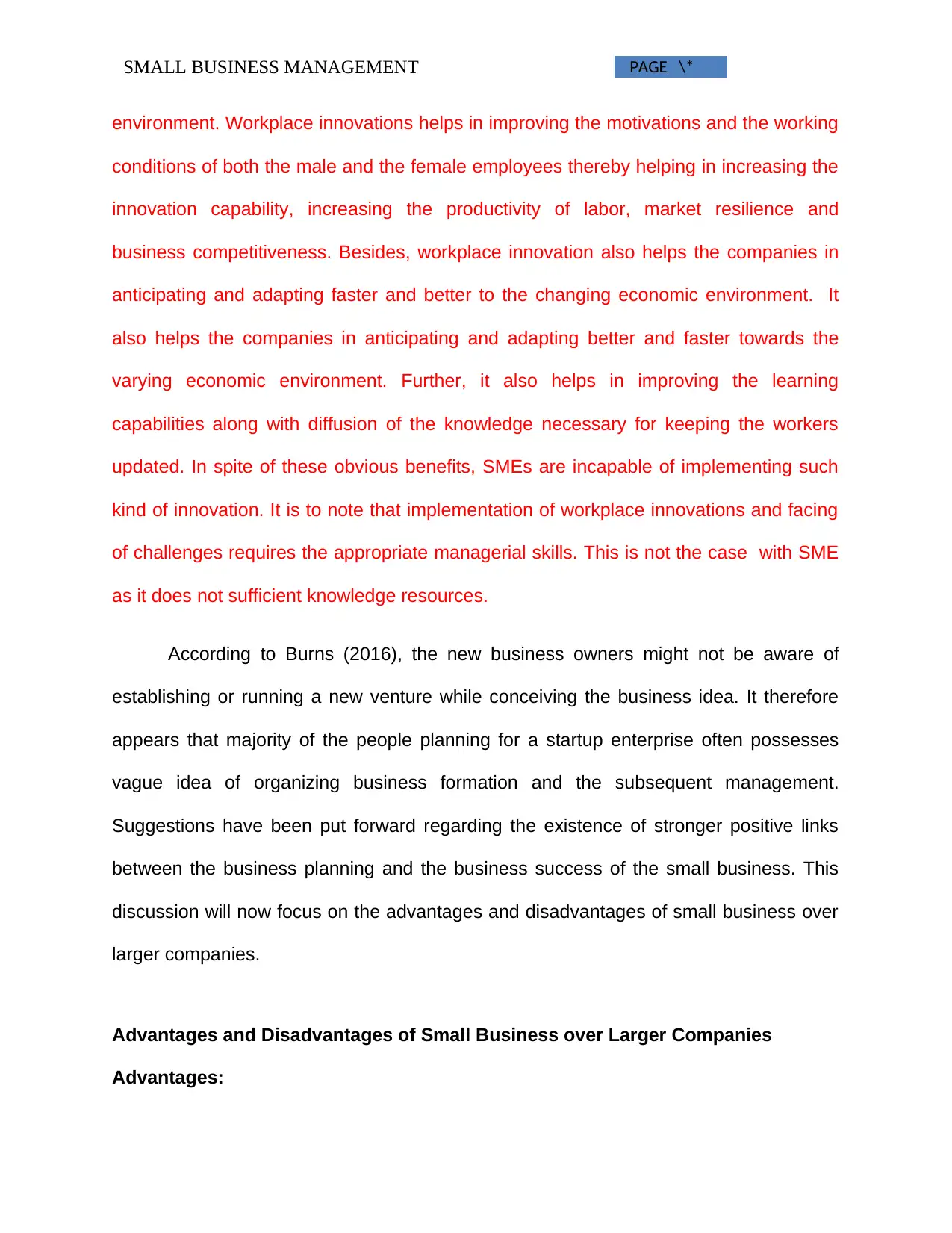
PAGE \*
MERGEFOR
SMALL BUSINESS MANAGEMENT
environment. Workplace innovations helps in improving the motivations and the working
conditions of both the male and the female employees thereby helping in increasing the
innovation capability, increasing the productivity of labor, market resilience and
business competitiveness. Besides, workplace innovation also helps the companies in
anticipating and adapting faster and better to the changing economic environment. It
also helps the companies in anticipating and adapting better and faster towards the
varying economic environment. Further, it also helps in improving the learning
capabilities along with diffusion of the knowledge necessary for keeping the workers
updated. In spite of these obvious benefits, SMEs are incapable of implementing such
kind of innovation. It is to note that implementation of workplace innovations and facing
of challenges requires the appropriate managerial skills. This is not the case with SME
as it does not sufficient knowledge resources.
According to Burns (2016), the new business owners might not be aware of
establishing or running a new venture while conceiving the business idea. It therefore
appears that majority of the people planning for a startup enterprise often possesses
vague idea of organizing business formation and the subsequent management.
Suggestions have been put forward regarding the existence of stronger positive links
between the business planning and the business success of the small business. This
discussion will now focus on the advantages and disadvantages of small business over
larger companies.
Advantages and Disadvantages of Small Business over Larger Companies
Advantages:
MERGEFOR
SMALL BUSINESS MANAGEMENT
environment. Workplace innovations helps in improving the motivations and the working
conditions of both the male and the female employees thereby helping in increasing the
innovation capability, increasing the productivity of labor, market resilience and
business competitiveness. Besides, workplace innovation also helps the companies in
anticipating and adapting faster and better to the changing economic environment. It
also helps the companies in anticipating and adapting better and faster towards the
varying economic environment. Further, it also helps in improving the learning
capabilities along with diffusion of the knowledge necessary for keeping the workers
updated. In spite of these obvious benefits, SMEs are incapable of implementing such
kind of innovation. It is to note that implementation of workplace innovations and facing
of challenges requires the appropriate managerial skills. This is not the case with SME
as it does not sufficient knowledge resources.
According to Burns (2016), the new business owners might not be aware of
establishing or running a new venture while conceiving the business idea. It therefore
appears that majority of the people planning for a startup enterprise often possesses
vague idea of organizing business formation and the subsequent management.
Suggestions have been put forward regarding the existence of stronger positive links
between the business planning and the business success of the small business. This
discussion will now focus on the advantages and disadvantages of small business over
larger companies.
Advantages and Disadvantages of Small Business over Larger Companies
Advantages:
Paraphrase This Document
Need a fresh take? Get an instant paraphrase of this document with our AI Paraphraser
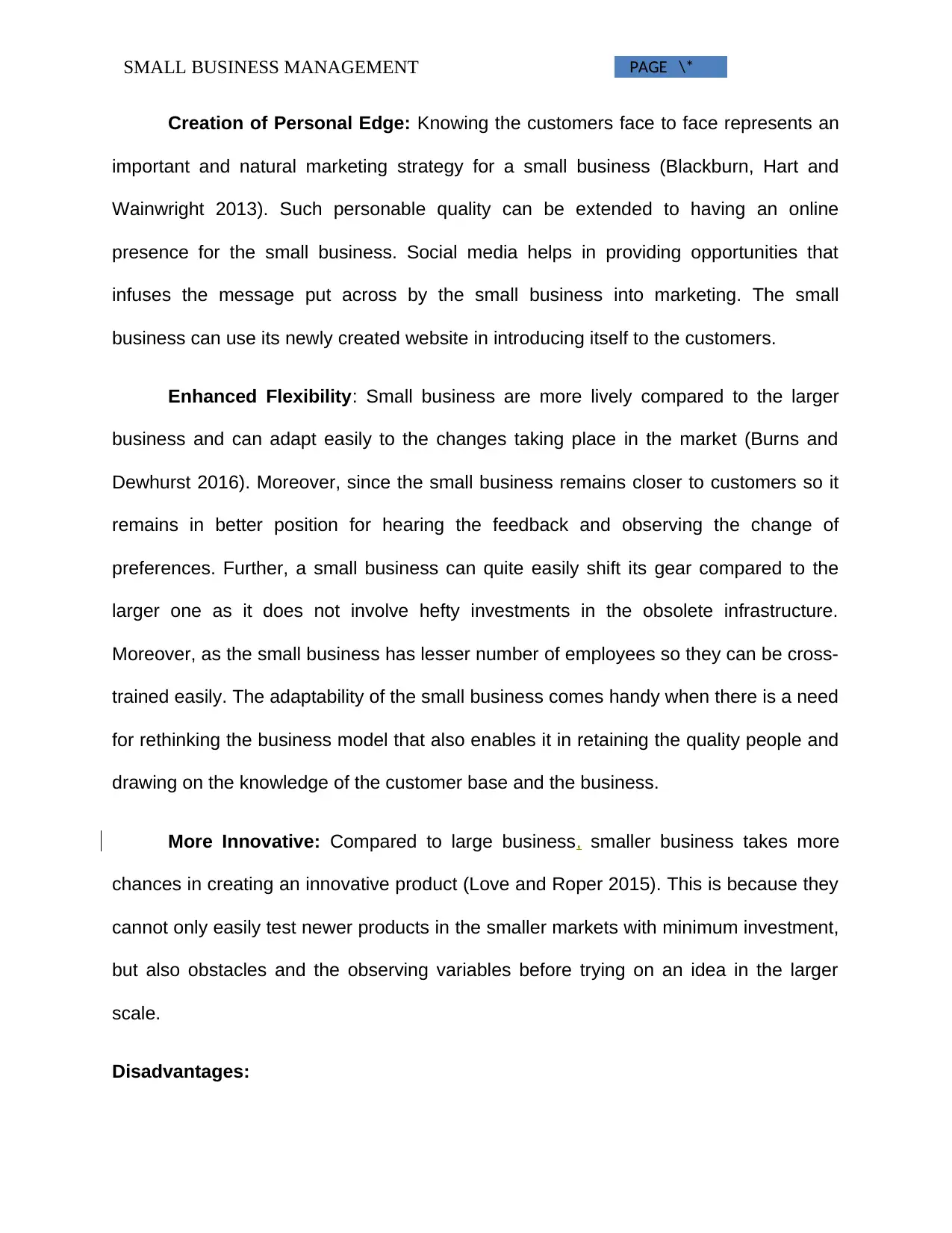
PAGE \*
MERGEFOR
SMALL BUSINESS MANAGEMENT
Creation of Personal Edge: Knowing the customers face to face represents an
important and natural marketing strategy for a small business (Blackburn, Hart and
Wainwright 2013). Such personable quality can be extended to having an online
presence for the small business. Social media helps in providing opportunities that
infuses the message put across by the small business into marketing. The small
business can use its newly created website in introducing itself to the customers.
Enhanced Flexibility: Small business are more lively compared to the larger
business and can adapt easily to the changes taking place in the market (Burns and
Dewhurst 2016). Moreover, since the small business remains closer to customers so it
remains in better position for hearing the feedback and observing the change of
preferences. Further, a small business can quite easily shift its gear compared to the
larger one as it does not involve hefty investments in the obsolete infrastructure.
Moreover, as the small business has lesser number of employees so they can be cross-
trained easily. The adaptability of the small business comes handy when there is a need
for rethinking the business model that also enables it in retaining the quality people and
drawing on the knowledge of the customer base and the business.
More Innovative: Compared to large business, smaller business takes more
chances in creating an innovative product (Love and Roper 2015). This is because they
cannot only easily test newer products in the smaller markets with minimum investment,
but also obstacles and the observing variables before trying on an idea in the larger
scale.
Disadvantages:
MERGEFOR
SMALL BUSINESS MANAGEMENT
Creation of Personal Edge: Knowing the customers face to face represents an
important and natural marketing strategy for a small business (Blackburn, Hart and
Wainwright 2013). Such personable quality can be extended to having an online
presence for the small business. Social media helps in providing opportunities that
infuses the message put across by the small business into marketing. The small
business can use its newly created website in introducing itself to the customers.
Enhanced Flexibility: Small business are more lively compared to the larger
business and can adapt easily to the changes taking place in the market (Burns and
Dewhurst 2016). Moreover, since the small business remains closer to customers so it
remains in better position for hearing the feedback and observing the change of
preferences. Further, a small business can quite easily shift its gear compared to the
larger one as it does not involve hefty investments in the obsolete infrastructure.
Moreover, as the small business has lesser number of employees so they can be cross-
trained easily. The adaptability of the small business comes handy when there is a need
for rethinking the business model that also enables it in retaining the quality people and
drawing on the knowledge of the customer base and the business.
More Innovative: Compared to large business, smaller business takes more
chances in creating an innovative product (Love and Roper 2015). This is because they
cannot only easily test newer products in the smaller markets with minimum investment,
but also obstacles and the observing variables before trying on an idea in the larger
scale.
Disadvantages:
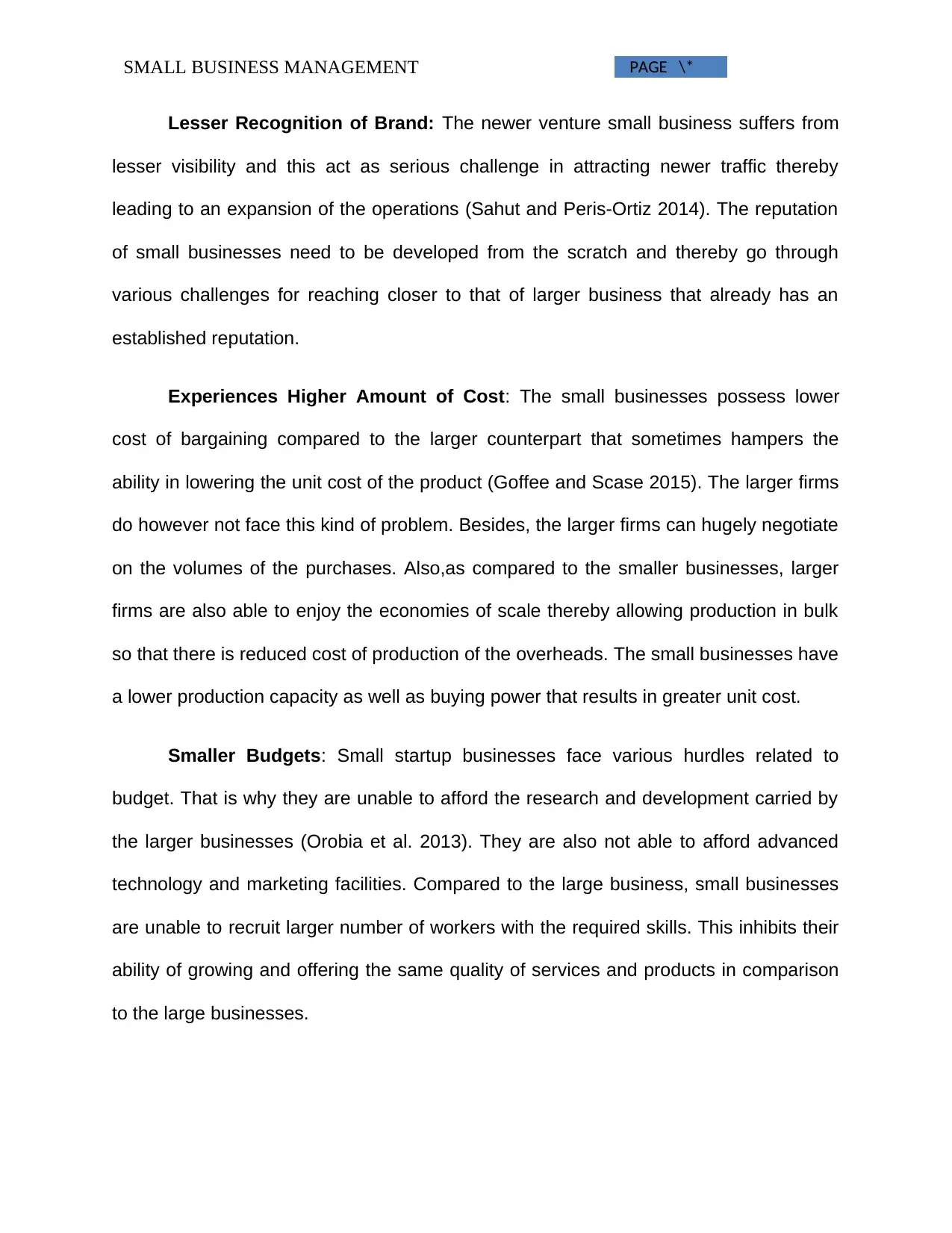
PAGE \*
MERGEFOR
SMALL BUSINESS MANAGEMENT
Lesser Recognition of Brand: The newer venture small business suffers from
lesser visibility and this act as serious challenge in attracting newer traffic thereby
leading to an expansion of the operations (Sahut and Peris-Ortiz 2014). The reputation
of small businesses need to be developed from the scratch and thereby go through
various challenges for reaching closer to that of larger business that already has an
established reputation.
Experiences Higher Amount of Cost: The small businesses possess lower
cost of bargaining compared to the larger counterpart that sometimes hampers the
ability in lowering the unit cost of the product (Goffee and Scase 2015). The larger firms
do however not face this kind of problem. Besides, the larger firms can hugely negotiate
on the volumes of the purchases. Also,as compared to the smaller businesses, larger
firms are also able to enjoy the economies of scale thereby allowing production in bulk
so that there is reduced cost of production of the overheads. The small businesses have
a lower production capacity as well as buying power that results in greater unit cost.
Smaller Budgets: Small startup businesses face various hurdles related to
budget. That is why they are unable to afford the research and development carried by
the larger businesses (Orobia et al. 2013). They are also not able to afford advanced
technology and marketing facilities. Compared to the large business, small businesses
are unable to recruit larger number of workers with the required skills. This inhibits their
ability of growing and offering the same quality of services and products in comparison
to the large businesses.
MERGEFOR
SMALL BUSINESS MANAGEMENT
Lesser Recognition of Brand: The newer venture small business suffers from
lesser visibility and this act as serious challenge in attracting newer traffic thereby
leading to an expansion of the operations (Sahut and Peris-Ortiz 2014). The reputation
of small businesses need to be developed from the scratch and thereby go through
various challenges for reaching closer to that of larger business that already has an
established reputation.
Experiences Higher Amount of Cost: The small businesses possess lower
cost of bargaining compared to the larger counterpart that sometimes hampers the
ability in lowering the unit cost of the product (Goffee and Scase 2015). The larger firms
do however not face this kind of problem. Besides, the larger firms can hugely negotiate
on the volumes of the purchases. Also,as compared to the smaller businesses, larger
firms are also able to enjoy the economies of scale thereby allowing production in bulk
so that there is reduced cost of production of the overheads. The small businesses have
a lower production capacity as well as buying power that results in greater unit cost.
Smaller Budgets: Small startup businesses face various hurdles related to
budget. That is why they are unable to afford the research and development carried by
the larger businesses (Orobia et al. 2013). They are also not able to afford advanced
technology and marketing facilities. Compared to the large business, small businesses
are unable to recruit larger number of workers with the required skills. This inhibits their
ability of growing and offering the same quality of services and products in comparison
to the large businesses.
⊘ This is a preview!⊘
Do you want full access?
Subscribe today to unlock all pages.

Trusted by 1+ million students worldwide
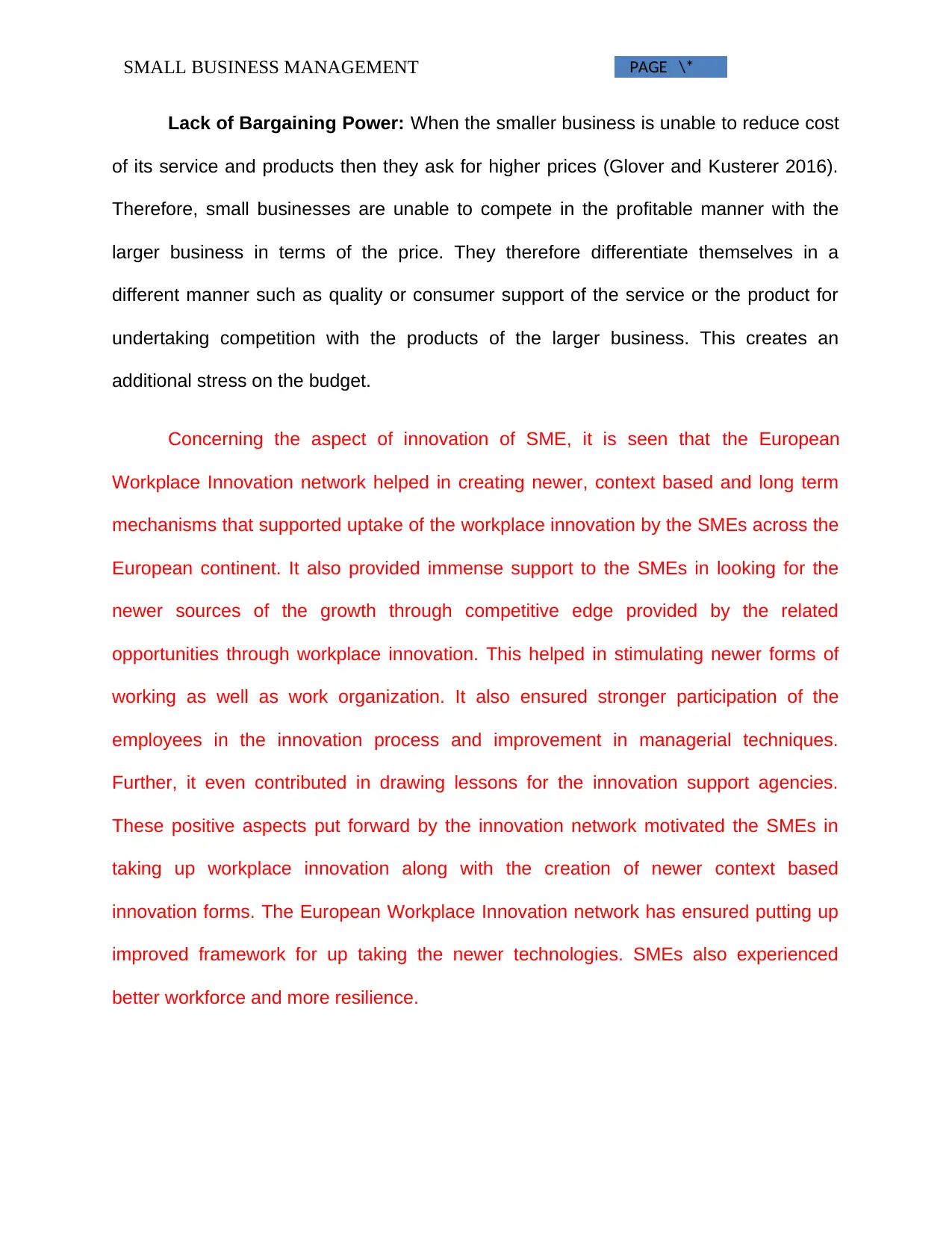
PAGE \*
MERGEFOR
SMALL BUSINESS MANAGEMENT
Lack of Bargaining Power: When the smaller business is unable to reduce cost
of its service and products then they ask for higher prices (Glover and Kusterer 2016).
Therefore, small businesses are unable to compete in the profitable manner with the
larger business in terms of the price. They therefore differentiate themselves in a
different manner such as quality or consumer support of the service or the product for
undertaking competition with the products of the larger business. This creates an
additional stress on the budget.
Concerning the aspect of innovation of SME, it is seen that the European
Workplace Innovation network helped in creating newer, context based and long term
mechanisms that supported uptake of the workplace innovation by the SMEs across the
European continent. It also provided immense support to the SMEs in looking for the
newer sources of the growth through competitive edge provided by the related
opportunities through workplace innovation. This helped in stimulating newer forms of
working as well as work organization. It also ensured stronger participation of the
employees in the innovation process and improvement in managerial techniques.
Further, it even contributed in drawing lessons for the innovation support agencies.
These positive aspects put forward by the innovation network motivated the SMEs in
taking up workplace innovation along with the creation of newer context based
innovation forms. The European Workplace Innovation network has ensured putting up
improved framework for up taking the newer technologies. SMEs also experienced
better workforce and more resilience.
MERGEFOR
SMALL BUSINESS MANAGEMENT
Lack of Bargaining Power: When the smaller business is unable to reduce cost
of its service and products then they ask for higher prices (Glover and Kusterer 2016).
Therefore, small businesses are unable to compete in the profitable manner with the
larger business in terms of the price. They therefore differentiate themselves in a
different manner such as quality or consumer support of the service or the product for
undertaking competition with the products of the larger business. This creates an
additional stress on the budget.
Concerning the aspect of innovation of SME, it is seen that the European
Workplace Innovation network helped in creating newer, context based and long term
mechanisms that supported uptake of the workplace innovation by the SMEs across the
European continent. It also provided immense support to the SMEs in looking for the
newer sources of the growth through competitive edge provided by the related
opportunities through workplace innovation. This helped in stimulating newer forms of
working as well as work organization. It also ensured stronger participation of the
employees in the innovation process and improvement in managerial techniques.
Further, it even contributed in drawing lessons for the innovation support agencies.
These positive aspects put forward by the innovation network motivated the SMEs in
taking up workplace innovation along with the creation of newer context based
innovation forms. The European Workplace Innovation network has ensured putting up
improved framework for up taking the newer technologies. SMEs also experienced
better workforce and more resilience.
Paraphrase This Document
Need a fresh take? Get an instant paraphrase of this document with our AI Paraphraser
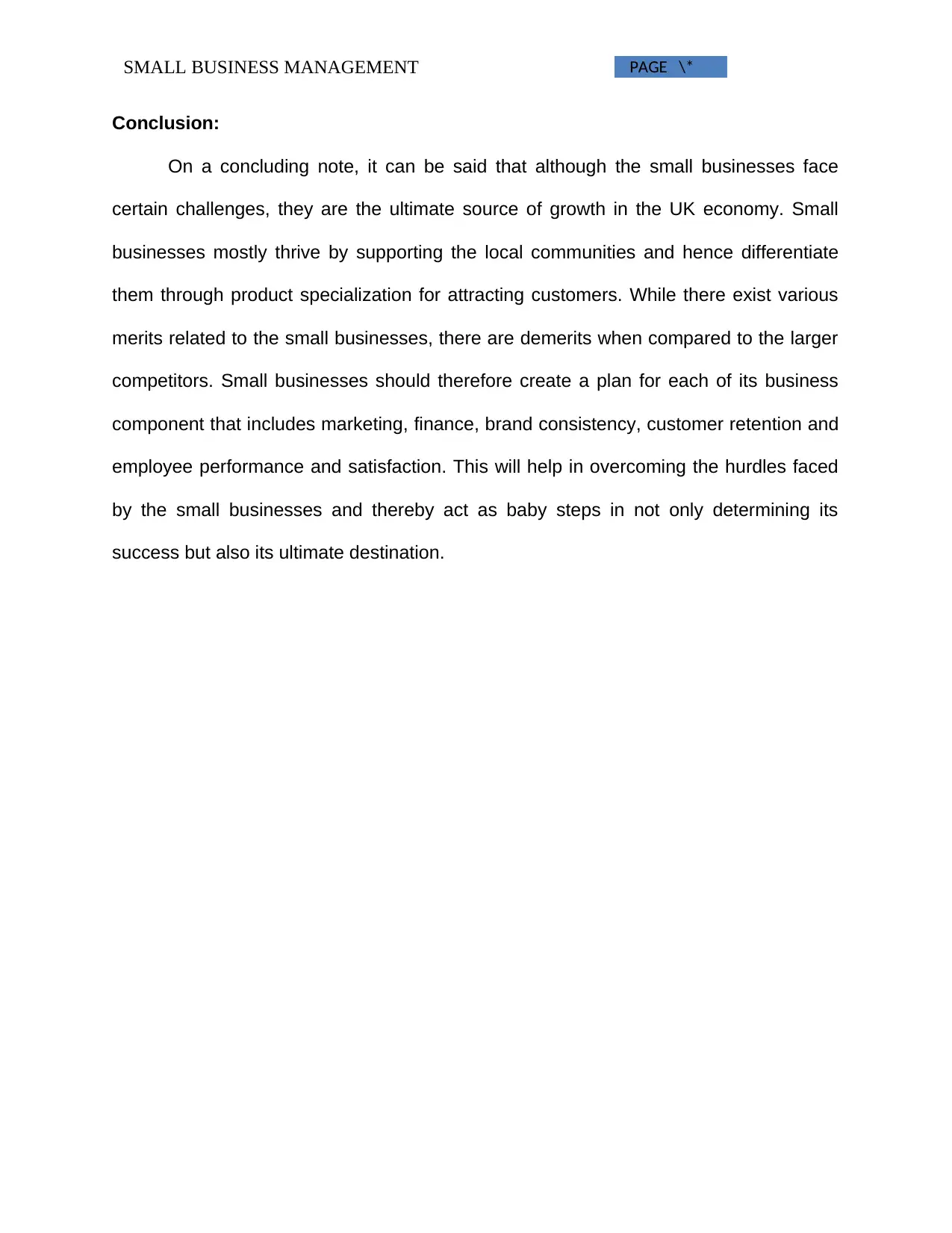
PAGE \*
MERGEFOR
SMALL BUSINESS MANAGEMENT
Conclusion:
On a concluding note, it can be said that although the small businesses face
certain challenges, they are the ultimate source of growth in the UK economy. Small
businesses mostly thrive by supporting the local communities and hence differentiate
them through product specialization for attracting customers. While there exist various
merits related to the small businesses, there are demerits when compared to the larger
competitors. Small businesses should therefore create a plan for each of its business
component that includes marketing, finance, brand consistency, customer retention and
employee performance and satisfaction. This will help in overcoming the hurdles faced
by the small businesses and thereby act as baby steps in not only determining its
success but also its ultimate destination.
MERGEFOR
SMALL BUSINESS MANAGEMENT
Conclusion:
On a concluding note, it can be said that although the small businesses face
certain challenges, they are the ultimate source of growth in the UK economy. Small
businesses mostly thrive by supporting the local communities and hence differentiate
them through product specialization for attracting customers. While there exist various
merits related to the small businesses, there are demerits when compared to the larger
competitors. Small businesses should therefore create a plan for each of its business
component that includes marketing, finance, brand consistency, customer retention and
employee performance and satisfaction. This will help in overcoming the hurdles faced
by the small businesses and thereby act as baby steps in not only determining its
success but also its ultimate destination.
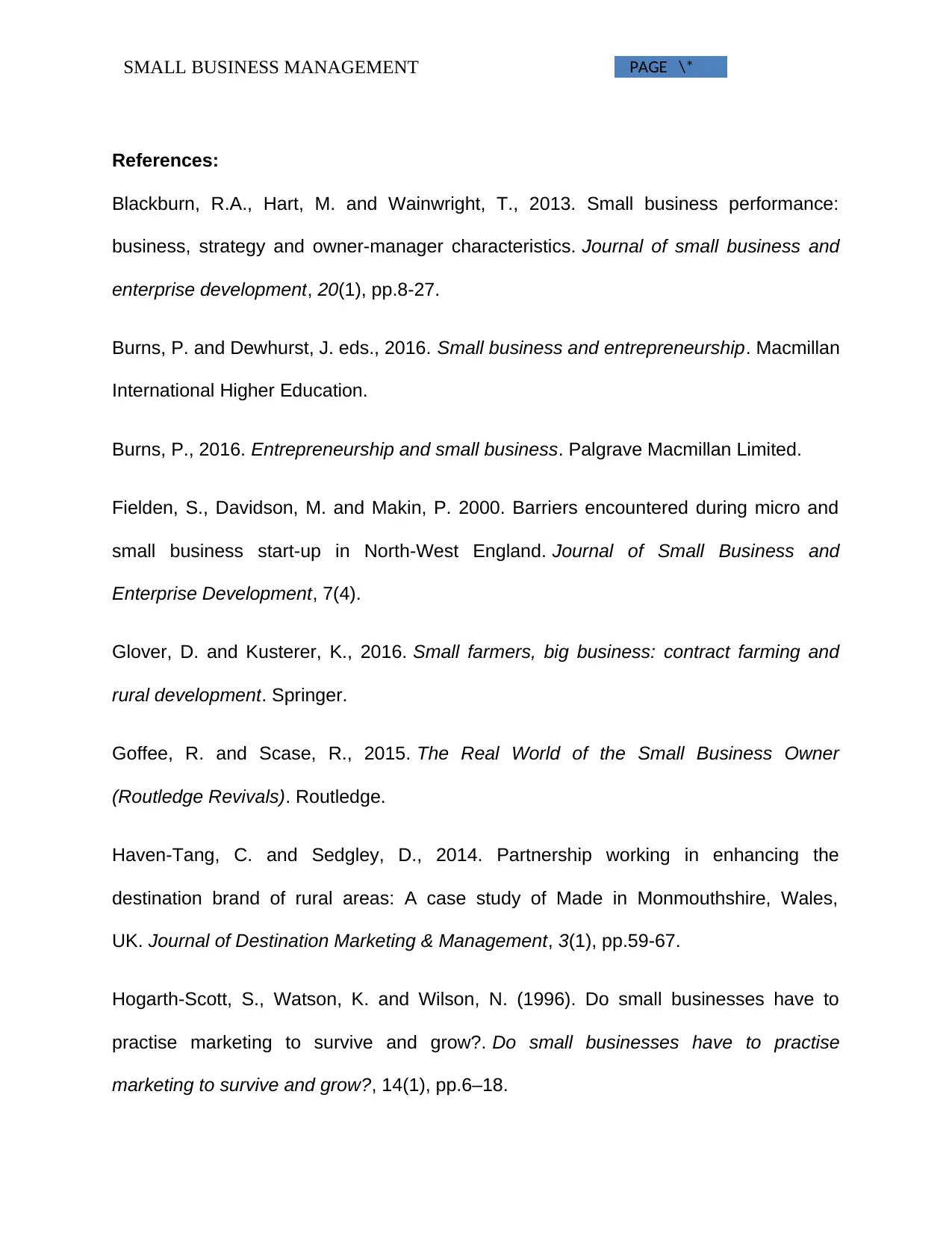
PAGE \*
MERGEFOR
SMALL BUSINESS MANAGEMENT
References:
Blackburn, R.A., Hart, M. and Wainwright, T., 2013. Small business performance:
business, strategy and owner-manager characteristics. Journal of small business and
enterprise development, 20(1), pp.8-27.
Burns, P. and Dewhurst, J. eds., 2016. Small business and entrepreneurship. Macmillan
International Higher Education.
Burns, P., 2016. Entrepreneurship and small business. Palgrave Macmillan Limited.
Fielden, S., Davidson, M. and Makin, P. 2000. Barriers encountered during micro and
small business start-up in North-West England. Journal of Small Business and
Enterprise Development, 7(4).
Glover, D. and Kusterer, K., 2016. Small farmers, big business: contract farming and
rural development. Springer.
Goffee, R. and Scase, R., 2015. The Real World of the Small Business Owner
(Routledge Revivals). Routledge.
Haven-Tang, C. and Sedgley, D., 2014. Partnership working in enhancing the
destination brand of rural areas: A case study of Made in Monmouthshire, Wales,
UK. Journal of Destination Marketing & Management, 3(1), pp.59-67.
Hogarth-Scott, S., Watson, K. and Wilson, N. (1996). Do small businesses have to
practise marketing to survive and grow?. Do small businesses have to practise
marketing to survive and grow?, 14(1), pp.6–18.
MERGEFOR
SMALL BUSINESS MANAGEMENT
References:
Blackburn, R.A., Hart, M. and Wainwright, T., 2013. Small business performance:
business, strategy and owner-manager characteristics. Journal of small business and
enterprise development, 20(1), pp.8-27.
Burns, P. and Dewhurst, J. eds., 2016. Small business and entrepreneurship. Macmillan
International Higher Education.
Burns, P., 2016. Entrepreneurship and small business. Palgrave Macmillan Limited.
Fielden, S., Davidson, M. and Makin, P. 2000. Barriers encountered during micro and
small business start-up in North-West England. Journal of Small Business and
Enterprise Development, 7(4).
Glover, D. and Kusterer, K., 2016. Small farmers, big business: contract farming and
rural development. Springer.
Goffee, R. and Scase, R., 2015. The Real World of the Small Business Owner
(Routledge Revivals). Routledge.
Haven-Tang, C. and Sedgley, D., 2014. Partnership working in enhancing the
destination brand of rural areas: A case study of Made in Monmouthshire, Wales,
UK. Journal of Destination Marketing & Management, 3(1), pp.59-67.
Hogarth-Scott, S., Watson, K. and Wilson, N. (1996). Do small businesses have to
practise marketing to survive and grow?. Do small businesses have to practise
marketing to survive and grow?, 14(1), pp.6–18.
⊘ This is a preview!⊘
Do you want full access?
Subscribe today to unlock all pages.

Trusted by 1+ million students worldwide
1 out of 13
Related Documents
Your All-in-One AI-Powered Toolkit for Academic Success.
+13062052269
info@desklib.com
Available 24*7 on WhatsApp / Email
![[object Object]](/_next/static/media/star-bottom.7253800d.svg)
Unlock your academic potential
Copyright © 2020–2025 A2Z Services. All Rights Reserved. Developed and managed by ZUCOL.





